The Root
Root develops from the radicle.
The Root Definition: The root is the underground descending, non-green part of a plant, which bears lateral branches and is devoid of leaves, buds, nodes, and internodes.
The Root Characteristics of roots:
- Roots are usually achlorophyllous (without chlorophyll) and so cannot perform photosynthesis.
- They are negatively phototropic (move away from light), positively geotropic (move in the direction of gravity), and positively hydrotropic (grow in water medium).
- Usually, they do not bear leaves, flowers, etc., but sometimes roots may bear vegetative buds.
- The growing root apex remains protected by the root cap or calyptra. In some aquatic plants, a loose thimble-like structure develops at the apex, called a root pocket.
- Root also bears unicellular ] hair-like projections of the epidermal cells called root hairs.
- The lateral branches of the root develop endogenously (from inside).
Read and Learn More: WBCHSE Notes for Class 11 Biology
Types Of Root
According to structure and mode of development,
The roots are classified into two types
- Adventitious roots, and
- True or tap root.
Taproot or Tree Root
Tree root Definition: The main root which is formed by the continuous growth of the radicle along with its branches and sub-branches is known as tap root or tree root.
Usually, tap roots are found in all dicotyledonous plants. Example Mangifera indica.
Tree root Characteristics:
- In dicot plants, the growing radicle moves straight downwards into the soil, forming the main root known as the primary root or tap root.
- Some thin and narrow roots that develop transversely from the tap roots are known as secondary or branch roots.
- The secondary roots further give rise to small, fine hair-like structures known as tertiary roots.
- All these roots together form the tap root system.
- Tertiary branches divide again and again to produce finer rootlets.
- A typical root has five regions— root cap region, region of elongation, root hair region, region of cell division, permanent region, or region of maturation.
Adventitious Roots
Adventitious Roots Definition: The roots that develop from any region of the plant body other than the radicle are known as adventitious roots.
Examples Of Adventitious Roots Are As Follows—
- From leaves, for example, Bryophyllum calycinum and Kalanchoe laciniata,
- From stems, for example, Zea mays (maize), Bambusa tulda (bamboo) Saccharum officinarum (sugarcane), and
- From the lower end of stem cuttings, for example, Hibiscus rosa-sinensis (china-rose), Rosa centifolia (rose), etc.
Fibrous Root System
In monocotyledonous plants, the tap root system is not well developed and may degenerate after some time. After degeneration of the primary root, some thin, thread-like, temporary roots develop from the base of the radicle. These roots are known as seminal roots.
After some time, some more fiber-like roots develop from the base of the plumule. These are called fibrous roots and together they form the fibrous root system. For example, Roots of wheat, grass, etc.
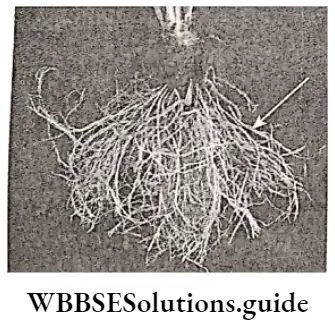
Different Regions Of A Typical Root And Their Functions
A typical root consists of the following five regions—
Root cap region: The root apex of the main root and its branches remain covered by a cap-shaped multicellular structure, called a root cap or calyptra.
Root cap region Characteristics:
- The root cap is formed of multicellular parenchymatous cells.
- Root cap is not found in aquatic plants. But in some aquatic plants (Eichhomia sp., Pistia sp., etc.), a thimble-like structure is found at the root apex. It is known as a root pocket.
- The root cap degenerates gradually with the growth of the root. In this case, new root caps originate from the region of elongation.
- Multiple root caps are found in the root tips of stilt roots of Pandanus sp., and prop roots of Ficus benghalensis.
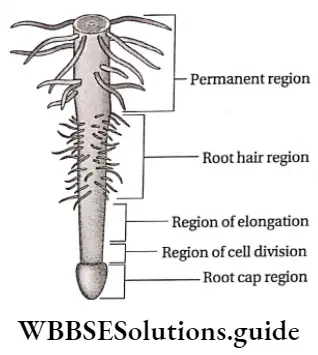
Root cap region Function:
- The root cap protects the root tip from the damage caused by friction with the soil particles.
- It secretes a mucilaginous substance, which helps the root tip to move easily into the soil by making it slippery.
Region of cell division: This region is present just above the root cap region. The cells of this region are isodiametric, thin-walled with dense cytoplasm and a large nucleus.
Region of cell division Characteristics: Cells of this region divide continuously to form new cells.
Region of cell division Function: Growth of the roots at this region takes place by continuous mitotic cell division.
Region of elongation: The small region, just above the region of cell division and below the root hair region, is known as the region of elongation.
Region of elongation Characteristics:
- This region consists of a soft and smooth outer wall
- ln this region’s cells elongate and enlarge raPidlY’ compared to other regions of the root.
Region of elongation Function: This region helps in root elongation.
Root hair region: This region is situated just above the region of elongation and is covered by clusters of very thin, unicellular tubular outgrowths, known as root hairs.
Root hair region Characteristics:
- The root hairs grow exogenously from the epidermal cells of the root.
- They remain alive for a few days or weeks.
- This region is also known as the piliferous region.
- Root hairs can remain active for up to 3 years in plants like Helianthus annus.
Root hair region Function:
- The root hairs help in both anchorage and absorption.
- They help in the absorption of water and minerals from the soil.
- Root hairs increase the surface area for absorption.
Permanent region: The region situated above the root hair region up to the base of the shoot, is known as the permanent region or Zone of Maturation.
Permanent region Characteristics:
- Branches are produced endogenously from this region.
- Cell division does not occur in this region. As a result growth of this region stops permanently.
Permanent region Function: It helps in the anchorage of plants to the soil and transportation of substances absorbed by root hairs.
Different Types Of Root Modification
In addition to normal functions, roots also perform some special functions such as storage of food, respiration, etc., in certain cases. For all these special functions, roots get modified in various ways.
Different types of tap root modifications
The tap roots are completely or partially modified according to their functional need. The different modifications of the tap root have been depicted in the following flow chart.
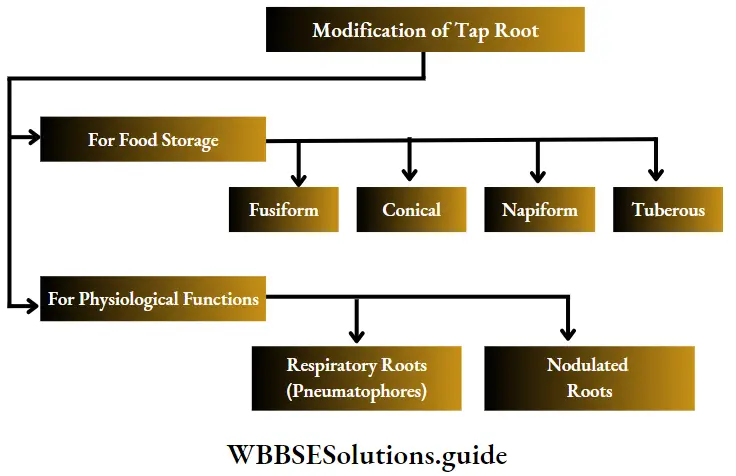
Modification for food storage: Due to the accumulation of reserve food, the tap roots of some plants develop into fleshy and swollen structures. The branch roots remain unchanged. These are of various shapes.
According to the shape, these tap roots are classified into the following types—
Fusiform: These roots are swollen in the middle and gradually taper at both ends. Secondary and tertiary roots develop. For example, as found in radish (Raphanus sativus)
Conical: These roots are broad at the base and gradually taper at the lower end forming a cone. The lower end of these roots contains branch roots. For example, as found in carrots (Daucus carota).
Napiform: These are much swollen. at the basa portion forming a spherical or globular structure, but abruptly taper towards the lower end. Numerous branch roots appear at the lower end. For example, as found in beetroot (Beta vulgaris), and turnip (Brassica rapa).
Tuberous: These roots become swollen without any definite shape. For example, as found in Ruellia tuberose.
Modifications for physiological functions: In many cases, the roots are modified to perform various physiological functions.
These modified roots are classified as follows—
Nodulated root: In leguminous plants, nodules are formed on the main root as well as on the branch roots. This happens due to the endogenous growth of nitrogen-fixing bacteria like Rhizobium. These types of roots are known as nodulated roots. For example, as found in Pisum sativum.
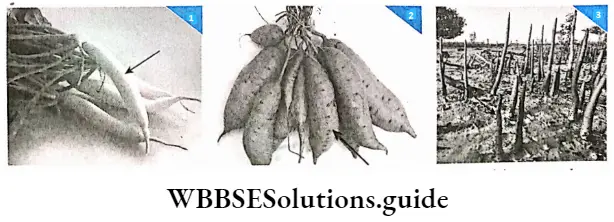
Respiratory root (Pneumatophores): In halophytes, some of the branches of the tap root grow vertically above the soil or water level for respiration.
The apical region of these roots bears pores, known as pneumatophores, through which gaseous exchange takes place. These roots are called pneumatophores or respiratory roots. example as found in Rhizophora mucronata (mangrove).
Different types of adventitious root modifications
The adventitious roots are variously modified for different functions. These are discussed below.
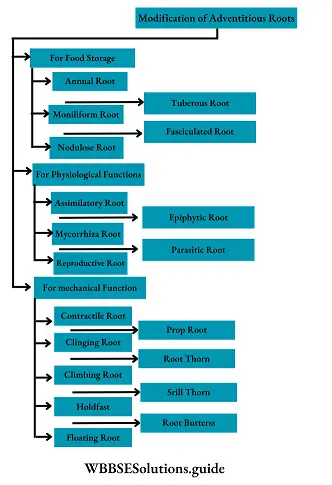
Modification for food storage: Different types of modification of adventitious roots for food storage are discussed as follows.
Tuberous roots: These tuber-like roots grow from fixing bacteria nodes of the prostrate stem (stem that grows along the ground) and become swollen irregularly by storing food. example found in Ipomoea batatas.
Fasciculated roots: These swollen tuberous roots grow in clusters, from a common point of origin at the base of the stem. example found in Asparagus racemosus.
Nodulose roots: These adventitious roots come out of the underground rhizomes. The roots become swollen at their apex forming nodule-like structures due to storage of food. example found in mango ginger (Curcuma amada).
Moniliform roots: These roots show alternate swollen and constricted regions. Thus, appear as beaded structures. example found in Dioscorea alata, Momordica sp.
Annulated roots: These thick roots look like an aggregation of rings in a series. example found in Ipecac (Cephaelis ipecacuanha).
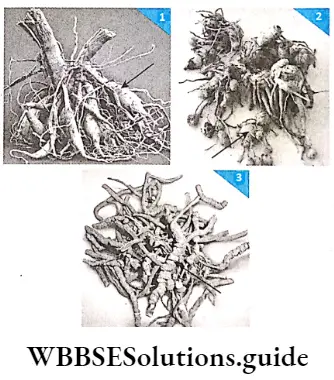
Modifications for physiological functions:
Different types of adventitious root modifications to carry out certain physiological functions are described below.
Epiphytic or hygroscopic roots: Some epiphytic orchids have freely hanging aerial roots along with clinging roots. The aerial roots are covered with a thin layer of spongy tissues, known as velamen. This layer absorbs moisture from the air and helps in Photosynthesis. example as found in Vanda tesselata.
Parasitic roots or haustoria or sucking roots: These are small, sucking roots found in parasitic plants. These roots penetrate the conducting tissues of the host plant and absorb nutrients from them. they may penetrate the vascular strands of the xylem and phloem of the host plants, for example as found in Dodder (Cuscuta reflexa).
Assimilatory or photosynthetic roots: These are long, chlorophyll-containing roots. These roots are able to be found in Podostemon sp Trapa sp. and Tinospora cordifolia.
Reproductive roots: These fleshy adventitious roots develop vegetative buds. These buds serve as the means of reproduction. The buds get separated from the mother plant and give rise to new plants getting favorable conditions. Example as found in sweet potato (Ipomoea batatus) and Dahlia sp.
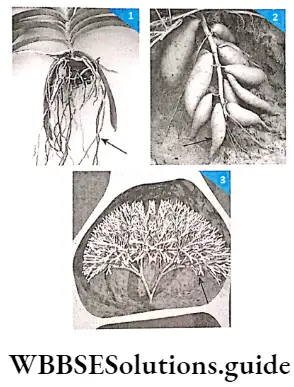
Mycorrhizal Roots: The roots of some plants are infested with fungal mycelia (singular: mycelium) which forms a symbiotic association with the plants. Such roots are called mycorrhizal roots.
The mycelia absorb nutrition from the soil which is used by both the plant and the fungi. example found in Pinus sp., Corallorhiza innata.
Modification for mechanical functions:
Different types of adventitious root modifications to carry out certain mechanical functions are described as follows.
Prop roots: These roots grow vertically downward, from the horizontal branches of the stem. Initially, the roots are hygroscopic (can absorb moisture from the air) but after reaching the soil each root grows into a thick and woody pillar-like structure.
They provide mechanical support to the branches. example found in Indian rubber (F’cus elastica) and banyan (Ficus benghalensis).
Stilt roots: These strong and stout roots are found in plants growing on soft soils, where anchorage is not so strong. They emerge obliquely from the basal node of the stems.
They provide mechanical support to the plant and help the P|ants to remain erect- stilt roots Perform the function of anchorage and prevent the plant from being uprooted.
Examples are found in screw pine (Pandanus foetida) and maize (Zea mays), sugarcane (Saccharum officinarum), and Sorghum (Sorghum vulgare).
Climbing roots: These roots grow from the nodes or internodes of some plants with weak stems. They help the plants to climb higher by attaching on to a stick or a tree as support.
The root tips of these plants secrete a viscous substance that helps the roots to stick to the supporting j structures. example found in betel vines (Piper betel).
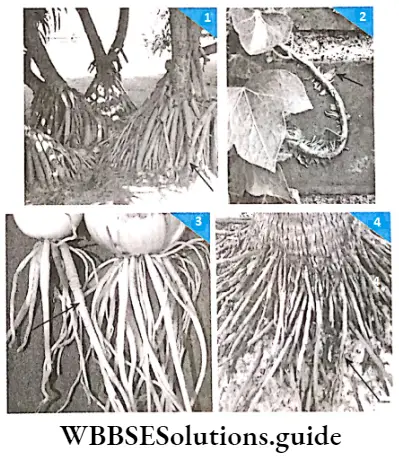
Clinging roots: These are very small roots developing from the nodes of certain parasitic plants. Clinging roots help the plant to anchor to the host plant and absorb nutrients from it example found in Vonda tessellata(Orchid).
Contractile or pull roots: This type of root develops from different underground stems like rhizome, bulb, corm, etc., in addition to other types of roots. These roots can contract and expand to maintain the proper position of the underground and the aerial parts of the underground stem. example found in Allium spv Crocus sp., Canna sp.
Root thorns: Some plants adventitiously develop sharp and pointed thorn-like structures from the lower nodes of the stem. These are called root thorns. These structures protect the plants from animals. example found in Pathos armatus.
Rootless plants
There are some rootless angiosperms such as Urticularia sp., a submerged aquatic plant. They have some finely dissected leaves which carry out the functions of the root.
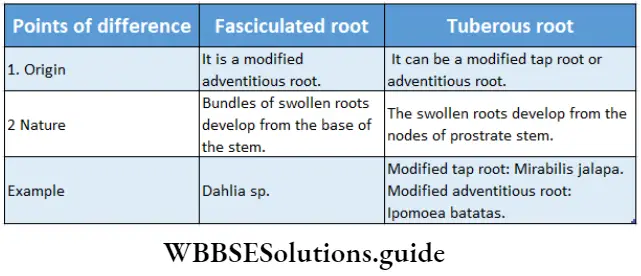
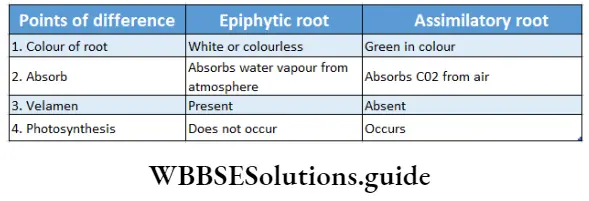

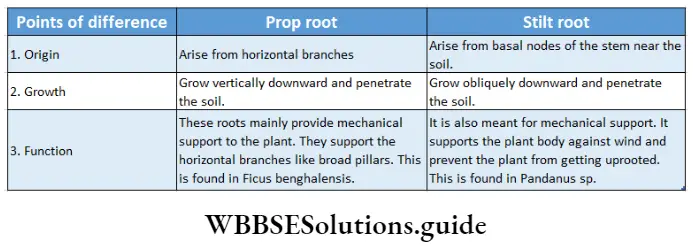

Functions Of Root
The functions of roots are as follows—
Primary functions:
The primary functions of roots are discussed as follows—
Mechanical function: The root system helps the plant to anchor in the soil and keep the plant upright.
Physiological Function:
Roots perform different physiological functions—
- Absorption: The root absorbs water and minerals from the soil.
- Conduction: Roots indirectly play an important role in the ascent of sap (upward movement of water in the plant body). These help in the conduction of water and minerals to different parts of the shoot system.
- Storage of food: Many roots help in food storage.
Special functions of modified roots: Besides the above primary functions, some roots get modified to carry out some special functions.
They are as follows
Mechanical Function:
- Prop roots of the banyan tree support the huge horizontal branches and maintain the erect position of the tree.
- Clinging roots (of orchids) and climbing roots (of betel vine) help the plants to climb on supporting objects (like a stick or a tree trunk).
- Some roots also provide support to the weak plants, for example, the stilt root of screw pine (Pandanus foetida).
- Roots also provide protection to the plants. For example, the root thorns of Pathos armatus protect the plants from herbivorous animals.
Physiological Function:
- Assimilatory roots help in carbon assimilation by photosynthesis. example assimilatory root of Trapa sp.
- Certain modified roots help in food storage. example storage root of sweet potato.
- Roots help in the absorption of moisture from the air. example epiphytic roots of orchids.
- In parasitic plants, certain roots help in J absorbing nutrients from the host plants. example haustoria of dodder (Cuscuta reflexa).
- Breathing roots or pneumatophores carry out gaseous exchange, Pneumatophores are observed in mangrove plants (for example Avicennia alba).
- Reproductive roots help in J reproduction by producing buds. example reproductive root of sweet potato (Ipomoea batatas).

